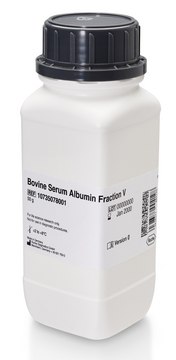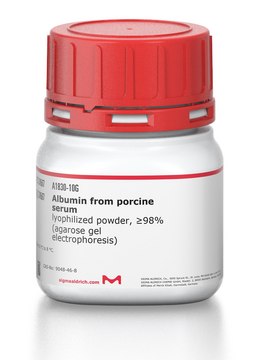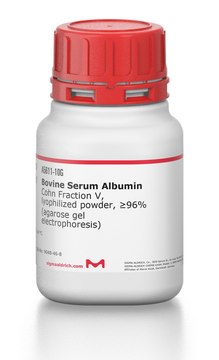A4737
Bovine Serum Albumin
lyophilized powder, protease, essentially free, ≥98% (agarose gel electrophoresis)
Synonym(s):
Albumin from bovine serum, Albumin bovine serum, BSA, Bovine albumin
Sign Into View Organizational & Contract Pricing
All Photos(4)
About This Item
Recommended Products
biological source
bovine
Assay
≥98% (agarose gel electrophoresis)
form
lyophilized powder
mol wt
~66 kDa
packaging
poly bottle of
origin
New Zealand origin
technique(s)
ligand binding assay: suitable
impurities
≤8.0% water (Karl Fischer)
pH
4.8-7.5
solubility
H2O: soluble 50 mg/mL
UniProt accession no.
foreign activity
protease, essentially free
storage temp.
2-8°C
Gene Information
bovine ... ALB(280717)
Looking for similar products? Visit Product Comparison Guide
General description
The most abundant plasma protein in mammals is albumin. It is produced in the liver and transferred as a non-glycosylated protein into the plasma. This multifunctional protein can bind to ligands.
Application
Bovine serum albumin (BSA) is extensively used for drug delivery since it is widely available, cheap and easily purified, has ligand-binding properties, and is widely accepted in the pharmaceutical industry.
Biochem/physiol Actions
Albumin is the most important circulatory protein involved in the control of Ca2+ (and Mg2+) levels in mammals.
Certain conformational and primary-sequence epitopes of BSA are suspected allergens in human beef and milk allergies.
Preparation Note
Purified by chromatography
Serum albumin may be referred to as Fraction V. This naming convention is taken from the original Cohn method of fractionating serum proteins using cold ethanol precipitation. Serum albumin was found in the fifth ethanol fraction using Cohn′s method. Since then, the term "Fraction V" has been used by some to describe serum albumin regardless of the method of preparation. Others have used this term to describe serum albumin purified by ethanol fractionation methods that have been highly modified since the original Cohn method was described. Sigma-Aldrich manufactures and distributes serum albumins purified from a variety of primary methods including the true Cohn fractionation method, modified ethanol fractionation methods, heat shock and chromatography. Additional purification steps may include crystallization or charcoal filtration.
Sourced and manufactured in New Zealand
Storage Class Code
11 - Combustible Solids
WGK
WGK 3
Flash Point(F)
Not applicable
Flash Point(C)
Not applicable
Choose from one of the most recent versions:
Already Own This Product?
Find documentation for the products that you have recently purchased in the Document Library.
Customers Also Viewed
Ting Gong et al.
Biology of reproduction, 95(6), 116-116 (2016-09-30)
Saccharin sodium consumption is considered safe and beneficial, owing to its very intense sweetness without any associated calories, but supporting scientific data remain sparse and controversial. Herein, we demonstrate that dose-response relationships existed with regard to administration of saccharin or
Yuangang Zu et al.
International journal of nanomedicine, 8, 1207-1222 (2013-04-10)
The livertaxis of glycyrrhizic acid-conjugated bovine serum albumin (GL-BSA) has been reported in the literature. Now, in this paper, we describe a novel type of drug-targeted delivery system containing 10-hydroxycamptothecin (HCPT) with liver tumor targeting. First, GL was coupled to
Karolina A Majorek et al.
Molecular immunology, 52(3-4), 174-182 (2012-06-09)
Serum albumin (SA) is the most abundant plasma protein in mammals. SA is a multifunctional protein with extraordinary ligand binding capacity, making it a transporter molecule for a diverse range of metabolites, drugs, nutrients, metals and other molecules. Due to
Junaid Akhtar et al.
Bio-protocol, 10(4), e3520-e3520 (2021-03-04)
Chromatin immunoprecipitation is extensively used to investigate the epigenetic profile and transcription factor binding sites in the genome. However, when the starting material is limited, the conventional ChIP-Seq approach cannot be implemented. This protocol describes a method that can be
Balázs Rada et al.
Journal of immunology (Baltimore, Md. : 1950), 181(7), 4883-4893 (2008-09-20)
The dual oxidase-thiocyanate-lactoperoxidase (Duox/SCN(-)/LPO) system generates the microbicidal oxidant hypothiocyanite in the airway surface liquid by using LPO, thiocyanate, and Duox-derived hydrogen peroxide released from the apical surface of the airway epithelium. This system is effective against several microorganisms that
Our team of scientists has experience in all areas of research including Life Science, Material Science, Chemical Synthesis, Chromatography, Analytical and many others.
Contact Technical Service





